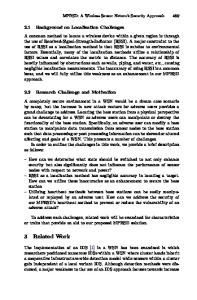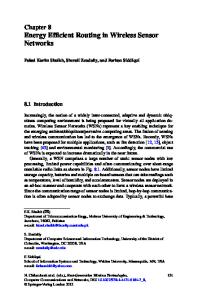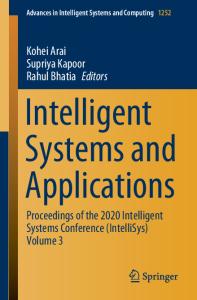A New Clustering-Based Approach for Target Tracking to Optimize Energy Consumption in Wireless Sensor Networks
- PDF / 1,081,622 Bytes
- 13 Pages / 439.37 x 666.142 pts Page_size
- 13 Downloads / 387 Views
A New Clustering‑Based Approach for Target Tracking to Optimize Energy Consumption in Wireless Sensor Networks Rahim Hosseini1 · Hamid Mirvaziri1
© Springer Science+Business Media, LLC, part of Springer Nature 2020
Abstract The emergence of wireless sensor networks is counted among the most significant achievements of the late 20’s. Nowadays, by the ever increasing utilization of new technologies, accessibility of distributed processing technologies and the rising demand for these technologies in regions unreachable or hard-to-reach for humans, their application is greatly expanded. In this study, the objective application is target tracking in protected zones. In this respect, tracking and accurate position reporting of targets in the defined time unit is the main objective. Nevertheless, one of the challenges in these networks is their short lifetime. This is due to the energy limitation of the power supply in each unit. The topic of target tracking in wireless sensor networks is of great importance because on one hand, for their lack of recharge ability, sensor nodes get depleted quite quickly, while on the other hand, losing the target is a highly undesirable event that may severely hamper the functionality of the network. Thus, we are searching for a solution that minimizes tracking errors. In this paper, we propose a strategy for target tracking in wireless sensor networks that is able to generate the least possible tracking error while consuming the minimum energy. Keywords Target tracking · K-means clustering algorithm · Wireless sensor networks · Energy optimization
1 Introduction Today, the application of WSN’s has greatly increased with the increasing trend of using novel technologies, accessibility of distributed processing technologies and increased demand for applying such technologies in hard-to-reach or unreachable areas [1, 2]. A sensor network comprises a structure of sensing, calculating and broadcasting components that enables a viewer to observe and adjust his observation, in a manner that giving proper response to the events occurring in the observed area is made simpler [3]. In this study, target tracking in protected areas is the intended application. In fact, all of the processes
* Hamid Mirvaziri [email protected] 1
Computer Engineering Department, Shahid Bahonar University, Kerman, Iran
13
Vol.:(0123456789)
R. Hosseini, H. Mirvaziri
of a wireless sensor network are used for setting up the capability of tracking an object in a designated area. Thus, the desired function is to track and accurately report the position of the object in each defined time unit [5, 6]. However, one of the problems of these networks is their short lifetime, which originates from the short lifetime of the nodes due to the limitations of power supply. In addition, sometimes, the abnormal status of a node intensifies the problem in the network. For example, a node that is one step away from a sink quickly runs out of energy because of high workload and in turn, its disability results in the interru
Data Loading...











